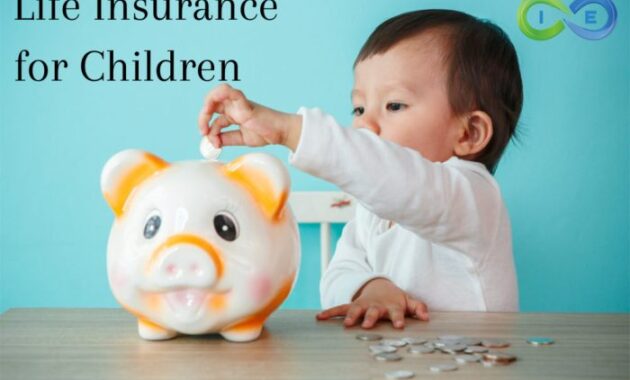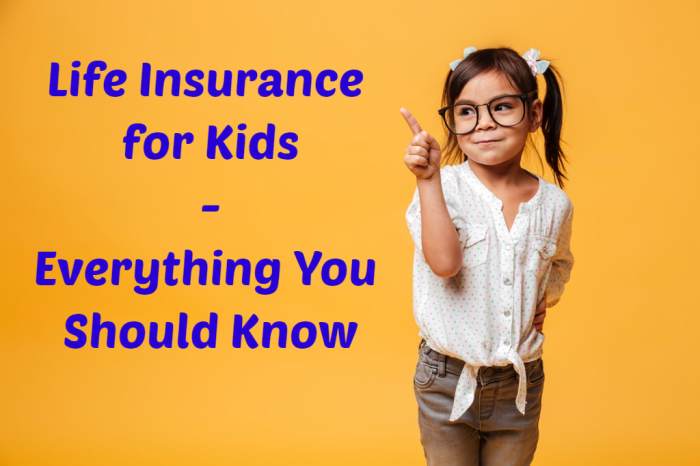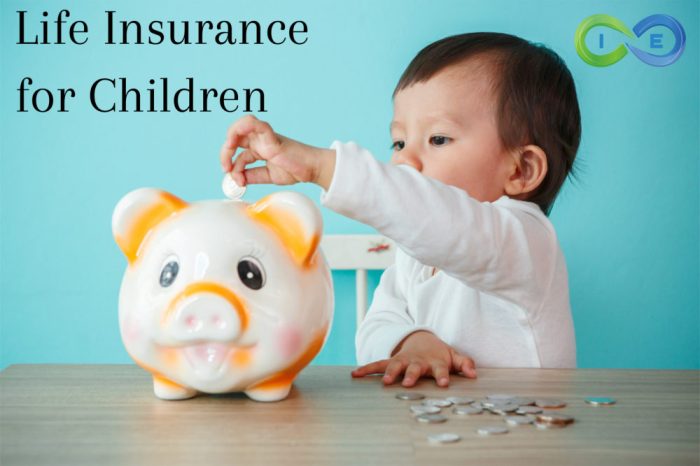
Planning for a child’s future often involves a myriad of considerations, from education to healthcare. A crucial, yet often overlooked, aspect is securing their financial well-being through children’s life insurance. This guide delves into the intricacies of various policy types, exploring their financial implications and addressing common concerns parents may have. We’ll examine the long-term benefits, legal considerations, and ethical implications involved in providing this crucial form of protection.
Understanding children’s life insurance goes beyond simply providing a financial safety net in case of the unthinkable. It’s about strategically planning for a secure future, enabling parents to address potential financial burdens while ensuring their child’s aspirations can be realized. This comprehensive overview will empower you to make informed decisions based on your family’s unique circumstances and financial goals.
Types of Children’s Life Insurance

Choosing the right life insurance policy for your child can seem daunting, but understanding the key differences between the main types available will help you make an informed decision. This section will explore term life insurance and whole life insurance, outlining their features, benefits, and ideal applications.
Term Life Insurance for Children
Term life insurance provides coverage for a specific period, or “term,” such as 10, 20, or 30 years. If the child passes away during the term, the death benefit is paid to the beneficiary. The premiums are generally lower than whole life insurance because the coverage is temporary. A common misconception is that children rarely need life insurance; however, term life insurance can be a valuable tool for families facing significant debt, like a mortgage, ensuring financial stability for the remaining family members in the event of the unexpected. One potential rider is an accidental death benefit, which pays a higher death benefit if the child dies due to an accident.
Whole Life Insurance for Children
Whole life insurance provides lifelong coverage, meaning it remains in effect until the policyholder’s death. Unlike term life insurance, whole life insurance also includes a cash value component that grows over time. This cash value can be borrowed against or withdrawn, offering a potential financial resource for the future. However, premiums are typically higher than term life insurance due to the lifelong coverage and cash value accumulation. A common rider for whole life insurance is a waiver of premium rider, which means that if the policyholder becomes disabled, the premiums are waived. This ensures the policy remains in force even if the policyholder can no longer afford the payments. Whole life insurance can be a sound financial investment for long-term planning and can be used to fund college expenses or other significant future needs.
Comparison of Term and Whole Life Insurance for Children
The choice between term and whole life insurance depends heavily on individual financial circumstances and long-term goals. Below is a table summarizing the key differences:
| Policy Type | Cost | Benefits | Suitability |
|---|---|---|---|
| Term Life Insurance | Lower premiums | Coverage for a specific term; potentially lower cost; simpler to understand | Families needing temporary coverage to address specific debts or financial obligations; situations where a large death benefit is needed at a lower cost. |
| Whole Life Insurance | Higher premiums | Lifelong coverage; cash value accumulation; potential for long-term financial growth; potential tax advantages; flexibility to borrow against cash value | Families seeking long-term financial security and wealth building; those who want a financial safety net for the future; parents wanting to establish a financial legacy. |
Financial Aspects of Children’s Life Insurance

Securing your child’s future often involves careful financial planning. Children’s life insurance plays a significant role in this, offering a safety net and potential for long-term financial growth. Understanding the financial implications is crucial before making a decision.
Factors Influencing the Cost of Children’s Life Insurance Premiums
Several factors influence the cost of children’s life insurance premiums. The most significant is the amount of coverage you choose – higher coverage naturally translates to higher premiums. The child’s health also plays a role; pre-existing conditions or family history of certain illnesses might increase premiums. The type of policy (term life, whole life, etc.) also greatly affects cost, with whole life policies generally having higher premiums but offering cash value accumulation. Your age as the policyholder and the insurer’s assessment of your risk profile will also be considered. Finally, the addition of riders, such as accidental death benefits, will increase the premium.
Long-Term Financial Benefits of Early Policy Purchase
Purchasing a children’s life insurance policy early offers several significant long-term financial advantages. Premiums are typically lower when the child is young and healthy, locking in a lower rate for the policy’s duration. This is because insurers assess risk based on age and health; younger children present a lower risk profile. Moreover, the policy can build cash value over time, especially with whole life policies, providing a savings component that can be accessed later for education, starting a business, or other financial needs. This cash value grows tax-deferred, providing a further financial benefit.
Life Insurance and Future Education Expenses
Life insurance can significantly contribute towards funding a child’s future education. The death benefit from a policy can cover tuition fees, living expenses, and other educational costs, ensuring the child’s educational aspirations are not compromised by unforeseen circumstances. For example, a $250,000 policy could comfortably cover a significant portion of a four-year college education, even with rising tuition costs. Furthermore, the cash value accumulated in a whole life policy can be used to pay for education expenses without impacting the death benefit.
Hypothetical Scenario: The Impact of Life Insurance
Let’s consider a hypothetical scenario: John purchases a $100,000 term life insurance policy for his 5-year-old daughter, Sarah, at a relatively low annual premium. Unfortunately, John passes away unexpectedly when Sarah is 15. The $100,000 death benefit provides financial security for Sarah and her mother, covering immediate expenses and providing a substantial fund for her future education and other needs. Without the policy, Sarah’s mother would face significant financial strain, potentially impacting Sarah’s quality of life and future opportunities. This demonstrates how a relatively small investment in life insurance can have a substantial positive impact on a child’s future.
Legal and Regulatory Considerations
Purchasing life insurance for a child involves navigating specific legal and regulatory frameworks designed to protect both the child and the policy’s financial integrity. These regulations vary by state and country, emphasizing the importance of understanding the applicable laws before proceeding. Key aspects include the legal capacity of minors to enter into contracts, the role of guardians in policy management, and the process of designating beneficiaries.
Guardian or Trustee’s Role in Policy Management
A guardian or trustee plays a crucial role in managing a child’s life insurance policy, especially when the child is a minor and lacks the legal capacity to manage their own financial affairs. The guardian or trustee acts on behalf of the child, making decisions regarding policy payments, changes to beneficiary designations, and other administrative tasks. Their responsibilities are clearly defined by law and are subject to oversight by the court, if necessary. This ensures the child’s interests are protected and the policy is managed responsibly. The specific legal requirements for guardians and trustees will depend on the jurisdiction and the terms Artikeld in the policy. For instance, a court may need to approve significant changes to the policy.
Beneficiary Designation for a Child’s Life Insurance Policy
Naming beneficiaries is a critical step in establishing a child’s life insurance policy. The beneficiary is the individual or entity who will receive the policy’s death benefit upon the child’s passing. Parents are commonly named as beneficiaries, ensuring the funds are available to support the child’s future or are used for other designated purposes. However, other individuals, such as grandparents or other relatives, or even trusts, can also be designated as beneficiaries. The choice of beneficiary should reflect the parents’ wishes and the best interests of the child. It’s advisable to review and update the beneficiary designation periodically, especially following significant life events, such as divorce or remarriage. Careful consideration of potential tax implications associated with beneficiary designations is also important.
Obtaining a Children’s Life Insurance Policy: A Step-by-Step Procedure
Securing a children’s life insurance policy generally involves a straightforward process. First, research and compare different insurers and policy types to find one that best fits the family’s needs and budget. Next, gather necessary information, such as the child’s birthdate and health information. Then, complete the application accurately and thoroughly, providing all required documentation. The insurer will then review the application and may require a medical examination depending on the policy’s type and coverage amount. Once approved, the policy is issued, and premium payments commence. It is crucial to carefully read the policy documents to fully understand the terms, conditions, and exclusions. Finally, maintain regular communication with the insurer regarding premium payments and any necessary policy updates. Keeping accurate records of all policy documents is essential for future reference.
Closing Summary

Securing your child’s future with life insurance requires careful consideration of various factors, from policy type and cost to legal and ethical implications. By understanding the different options available and their long-term financial benefits, parents can make informed decisions that provide peace of mind and a strong financial foundation for their children. Remember, proactive planning today can significantly impact your child’s future prospects, ensuring they have the resources to pursue their dreams and overcome unforeseen challenges.
Common Queries
What is the minimum age to purchase a children’s life insurance policy?
The minimum age varies by insurer, but it’s typically quite young, often as early as newborn.
Can I change the beneficiary of my child’s life insurance policy?
Yes, you can usually change the beneficiary at any time, but you’ll need to follow the insurer’s procedures.
What happens to the policy if I die and my child is still a minor?
The designated beneficiary will receive the death benefit, often managed by a guardian or trustee until the child reaches adulthood.
Are there tax implications associated with children’s life insurance?
The tax implications can be complex and depend on factors like the policy type and how the death benefit is used. Consult a financial advisor for personalized guidance.
How does children’s life insurance differ from adult life insurance?
Children’s life insurance often comes with lower premiums initially, and some policies include options for increasing coverage as the child grows older. The focus is often on long-term financial planning rather than immediate death benefit needs.